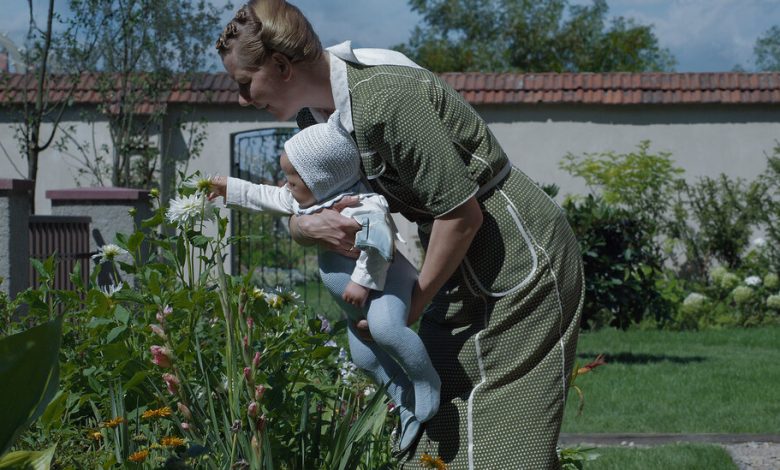‘The Zone of Interest’ Review: The Holocaust, Reduced to Background Noise

What is the point of “The Zone of Interest”? I’ve seen Jonathan Glazer’s movie twice, and each time I’ve returned to this question, something that I rarely feel compelled to ask. Movies exist because someone needs or wants to make art, tell a story, drive home a point, defend a cause, expose a wrong or simply make money. All that is clear from what’s onscreen is Glazer has made a hollow, self-aggrandizing art-film exercise set in Auschwitz during the Holocaust.
Written and directed by Glazer, the movie is loosely based on the 2014 novel by Martin Amis with the same title. Heavily researched — Amis lists numerous resources in the emotional afterward — the book is narrated by three men, including a fictionalized character based on Rudolf Höss, the S.S. commandant who for several years ran Auschwitz. There, he oversaw a factory of torture and death in which, per the Auschwitz-Birkenau State Museum, an estimated 1.1 million men, women and children were murdered, the vast majority Jews.
In adapting the novel, Glazer has jettisoned much of Amis’s novel, most of its characters, plotlines and inventive, at times near-hysteric, language and tone. What Glazer has retained is the novel’s intimate juxtaposition between the horrors of the extermination camp and the everyday lives of its non-inmate characters. Unlike Amis, however, who routinely invokes and at times describes the barbarism inside the camp — with its “daily berm of corpses,” as he writes — Glazer significantly and pointedly keeps these horrors at an oblique remove.
Instead, Glazer focuses on the day-to-day routine of the camp’s commandant and his family, using their real names. Together with their five children and a smattering of servants, Rudolf and Hedwig Höss — played by the relatively undemonstrative Christian Friedel and Sandra Hüller — live in a nondescript, somewhat austere, predictably orderly multistory house. There’s a spacious garden with a small wading pool, beehives, a sprawling greenhouse and beds of flowers tended by camp prisoners. A tall wall topped with barbed wire borders the garden; through the wire, the tops of numerous death camp buildings dot the view.
The proximity of their home and these buildings is a jolt, and based on fact. The real Höss family, like their fictional counterparts, lived in the Auschwitz complex, a swath some 15 square miles in size that housed different camps in an area called the Interessengebiet or “interest zone.” The house was tucked near a corner of the oldest camp, Auschwitz I, which had prisoner barracks, gallows, a gas chamber and crematory. After Höss was arrested in 1946, he wrote that “my family had it good in Auschwitz, every wish that my wife or my children had was fulfilled.” The children ran free and his wife had “her flower paradise.” He was hanged at Auschwitz in 1947, not far from where the family had lived.
The time frame in Glazer’s adaptation is vague, though primarily seems to take place in 1943 before the real Höss was transferred to another camp. The movie opens on a black screen accompanied by some music, a foreboding overture that gives way to a pacific scene at a river with a group of people in bathing suits. Eventually, they dress and motor off. Much of the rest of the movie takes place at the Höss family home, where Glazer’s carefully framed, often fixed cameras record the children playing while the parents chat and sometimes argue. You see Rudolf going off to work in the camp while Hedwig oversees the house. At one point, you also watch a prisoner quietly spreading ash on the garden as a soil amendment.
In “The Zone of Interest,” Glazer deploys a number of art-film conventions, including narrative ellipses and long uninterrupted takes. Throughout, characters are kept at a remove (as if they are being surveilled) and filmed mostly in medium or long shots; I only remember one grim close-up of a face. There are bursts of music (by Mica Levi), one bit features unnerving yelping and whooping, though not a conventional soundtrack. For the most part, the intricately layered audio foregrounds everyday conversations and chatter over a low, persistent machinelike hum, a droning that is regularly punctuated by train sounds, muffled gunfire and indecipherable yelling and screaming. It sounds like the engine of death.
The overall effect of Glazer’s approach to this material is at first deeply unsettling, in large part because — as ordinary life ticks on — you worry that he will take you into the extermination rooms. Instead, he continues focusing on the Hösses’ everyday life without obvious editorializing (or outrage), swells of emotion-coaxing music or the usual mainstream cinematic prompts. The camerawork — save for a few traveling shots that underline the closeness of the house to the interior of the camp — is smooth and discreet. It’s demonstrably unshowy. It’s all very matter of fact, whether Hedwig is showing a visitor around the garden or Rudolph is with some suited executives discussing plans to expand the camp.
In stressing the quotidian aspect and placid texture of the family’s life, Glazer emphasizes just how commonplace this world is, a mundanity that invokes what Hannah Arendt, in writing about the trial of Adolf Eichmann, one of the organizers of the Holocaust, famously called the “banality of evil.” Rudolf and Hedwig give the appearance of a conventional bourgeois married couple (however creepy). When he gets a promotion that requires them to move, she resists. Every so often, though, fissures crack the surface of this calm as when Hedwig tries on a fur coat that’s been confiscated from a prisoner; she shuts herself in a room first, which suggests that she’s hiding and, by extension, knows she’s doing something wrong.
There are other disturbances, too, like the clouds of dark smoke and the screams that one of the children hears and which discomfort him. More dramatically, Glazer inserts several eerie black-and-white scenes of a girl or young woman placing apples around the camp at night, presumably for prisoners. (Later, you learn that she’s an outsider.) These interludes are radically distinct in look and tone from the rest of the movie: They were shot with a thermal imaging camera and are accompanied by violent music. They also show the only instances of kindness and resistance in the entire movie. Yet what is most striking about these sections isn’t the singularity of this woman’s actions but their stylistic bravura, their wow factor.
“The Zone of Interest” is a blunt, obvious movie. In scene after scene, Glazer underscores the blandness of these characters’ lives without resorting to exegesis, weeping violins and faces or, instructively, a heroic figure like Oskar Schindler, the German industrialist who helped save hundreds of Jews and is the title character in Steven Spielberg’s 1993 film “Schindler’s List.” Spielberg’s film has been criticized for, among other things, focusing on a non-Jewish hero, a focus that speaks both to most filmmakers’ inability to honestly engage with the Holocaust — in its full, numbing, routinized barbarism — and to mainstream cinema’s compulsive desire for happy endings or at least some reassurances in the face of the abyss.
Glazer peers into the abyss but wisely doesn’t attempt to “explain” the Holocaust. Notably Rudolf and Hedwig don’t spew Nazi ideology; they embody it, which is foundational to the movie’s conceit. Deeply self-interested, they enjoy their power. They are, the movie suggests, representative of the millions of ordinary Germans — and, yes, perhaps anyone, anywhere — who chatted over breakfast while their neighbors were slaughtered. As Hedwig reminds Rudolf in one scene, they have the life they’ve always dreamed of. They are villains, full stop. And like so many other movies, mainstream or not, this one is fascinated with its villains, far more than it is with their victims, whose suffering here is largely reduced to room tone.
In “The Zone of Interest,” Glazer doesn’t simply tell a story; in his use of art-film conventions he provides a specific frame through which to watch it. This is clearly part of its attraction as is the breathing space his approach creates: it is scary, but not too.
These conventions can create a sense of intellectual distance and serve as a critique, or that’s the idea. They also announce (fairly or not) a filmmaker’s aesthetic bona fides, seriousness, sophistication and familiarity with a comparatively rarefied cinematic tradition. They signal that the film you’re watching is different from popular ones made for a mass audience. These conventions are markers of distinction, of quality, which flatter filmmakers and viewers alike, and which finally seem to me to be the biggest point of this vacuous movie.
Zone of Interest
Rated PG-13 for references to the mass death. Running time: 1 hour 45 minutes. In theaters.




